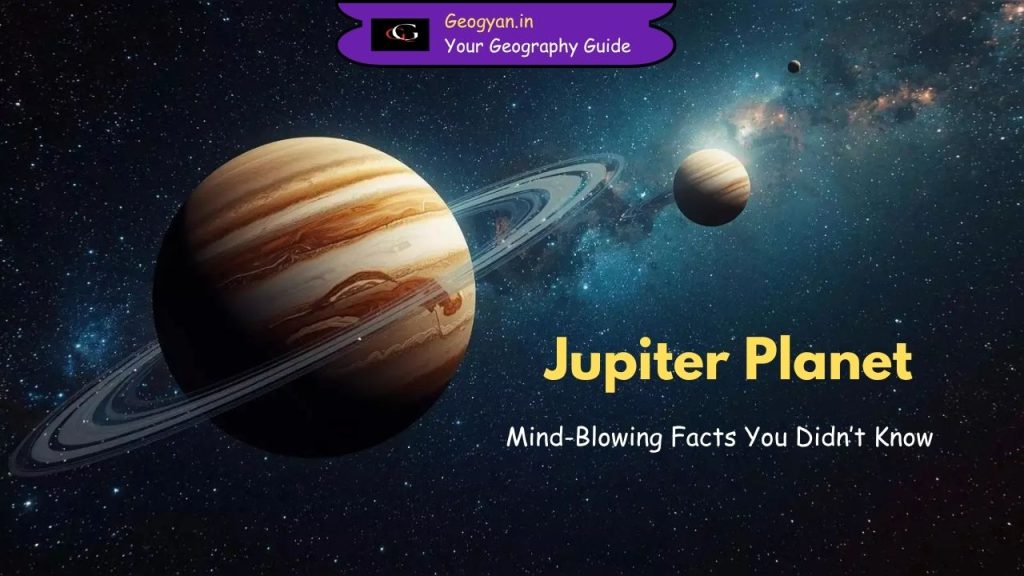Estimated reading time: 4 minutes

Table of contents
- Why is Jupiter Planet in the News
- Why Is Jupiter Called the Gas Giant?
- Main Physical Features of Jupiter?
- How Does Jupiter Influence the Solar System’s Geography?
- Why Does Jupiter Have the Great Red Spot?
- Jupiter’s Important Moons and Their Geographical Significance?
- What Makes Jupiter’s Magnetic Field So Powerful?
- Quick Facts About Jupiter Planet
- FAQs
- Also Read
Why is Jupiter Planet in the News
NASA’s Juno spacecraft, which has been orbiting Jupiter since 2016, reached the scheduled end of its mission on September 30, 2025. However, a US government shutdown has left scientists and the public uncertain if the probe is still operational since NASA cannot confirm whether Juno has been powered down. Juno provided nearly a decade of valuable insights into Jupiter’s atmosphere, magnetosphere, rings, and moons.
Why Is Jupiter Called the Gas Giant?
Jupiter is the largest planet in our Solar System, with a mass more than 300 times that of Earth. It’s known as a gas giant because it lacks a solid surface and is primarily composed of hydrogen and helium.
From a geographical perspective, Jupiter plays a crucial role in shaping the solar system’s structure, acting as a gravitational shield that protects inner planets like Earth from comets and asteroids.
Main Physical Features of Jupiter?
| Feature | Description |
| Diameter | ~142,984 km (11 times that of Earth) |
| Mass | 1.90 × 10²⁷ kg |
| Rotation Period | ~9.9 hours (fastest in the solar system) |
| Orbital Period | 11.86 Earth years |
| Atmosphere | Hydrogen (90%), Helium (10%) |
| Surface Temperature | -108°C on average |
| Moons | 95 confirmed (including Europa, Ganymede, Io, Callisto) |
| Rings | Faint system of dust rings |
| Magnetic Field | 20,000 times stronger than Earth’s |
How Does Jupiter Influence the Solar System’s Geography?
Jupiter’s massive gravity well affects the orbital paths of many asteroids in the Asteroid Belt. It is often called the “Solar System’s Vacuum Cleaner” because it captures or deflects dangerous comets.
Its magnetosphere, the largest structure in our solar system after the Sun’s influence, extends over 7 million km in space.
From a geographical standpoint, Jupiter helps maintain planetary stability, preventing excessive asteroid collisions with Earth — a key factor in sustaining life here.
Why Does Jupiter Have the Great Red Spot?
The Great Red Spot is a massive storm larger than Earth that has been raging for over 350 years. This anticyclonic storm is sustained by Jupiter’s fast rotation and internal heat, giving it a reddish hue due to chemical reactions in the upper atmosphere.
Its persistence provides vital data on planetary weather systems and atmospheric dynamics useful for understanding Earth’s climatic behavior.
Jupiter’s Important Moons and Their Geographical Significance?
Jupiter has 95 moons, but the four Galilean moons — Io, Europa, Ganymede, and Callisto — are the most significant.
- Io: The most volcanically active body in the Solar System.
- Europa: Possibly holds a subsurface ocean, making it a target in the search for life.
- Ganymede: The largest moon in the Solar System — even bigger than Mercury.
- Callisto: Covered with craters, representing ancient Solar System history.
These moons are like mini planets, each contributing to our understanding of planetary evolution and geography beyond Earth.
What Makes Jupiter’s Magnetic Field So Powerful?
Jupiter’s magnetic field is created by metallic hydrogen deep within its core.
This generates a strong dynamo effect, resulting in radiation belts that can destroy spacecraft electronics.
This extreme magnetic influence also helps in deflecting solar wind, maintaining a stable heliospheric environment for inner planets.
Quick Facts About Jupiter Planet
| Fact | Detail |
| 5th planet from the Sun | Between Mars and Saturn |
| Named after | Roman King of Gods “Jupiter” |
| Composition | Mostly hydrogen and helium |
| Gravity | 2.5 times Earth’s gravity |
| Visible from Earth | Yes, with naked eyes |
| Discovered by | Known since ancient times |
| Rotation speed | Fastest among all planets |
| Moons | 95 confirmed |
| Largest moon | Ganymede |
FAQs
Q1. Why is Jupiter called a Gas Giant?
Because it is composed mainly of hydrogen and helium gases, with no solid surface like Earth or Mars.
Q2. Which are the four Galilean moons of Jupiter?
They are Io, Europa, Ganymede, and Callisto, discovered by Galileo Galilei in 1610.
Q3. What makes Jupiter important for Earth’s protection?
Jupiter’s strong gravitational pull captures asteroids and comets, preventing many potential impacts on Earth.
Q4. Does Jupiter have rings like Saturn?
Yes, but Jupiter’s rings are faint and made of dust particles, discovered by the Voyager 1 mission in 1979.
Q5. What is the Great Red Spot?
It is a giant storm system in Jupiter’s atmosphere, large enough to fit three Earths inside it.





























